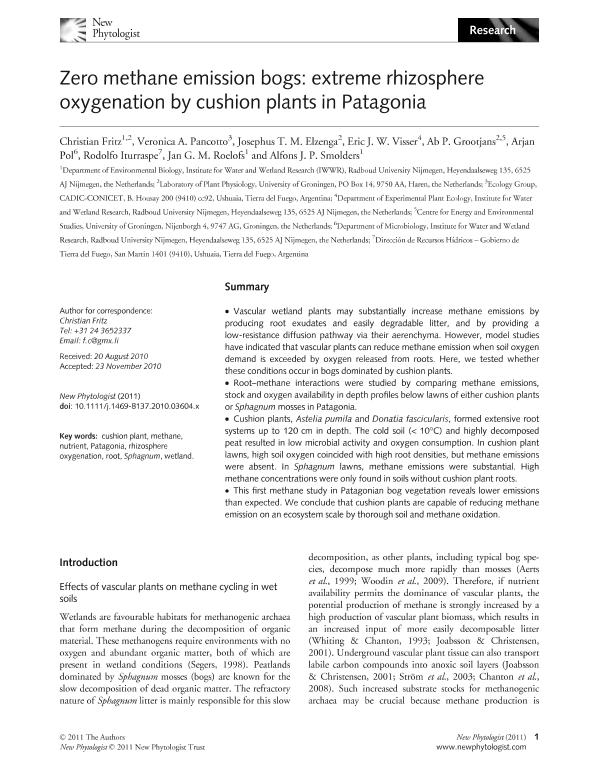Artículo
Zero methane emission bogs: extreme rhizosphere oxygenation by cushion plants in Patagonia
Fritz, Christian ; Pancotto, Veronica Andrea ; Elzenga, Josephus T. M.; Visser, Eric J. W.; Grootjans, Ab P.; Pol, Arjan; Iturraspe, Rodolfo Javier
; Elzenga, Josephus T. M.; Visser, Eric J. W.; Grootjans, Ab P.; Pol, Arjan; Iturraspe, Rodolfo Javier ; Roelofs, Jan G. M.; Smolders, Alfons J.
; Roelofs, Jan G. M.; Smolders, Alfons J.
 ; Elzenga, Josephus T. M.; Visser, Eric J. W.; Grootjans, Ab P.; Pol, Arjan; Iturraspe, Rodolfo Javier
; Elzenga, Josephus T. M.; Visser, Eric J. W.; Grootjans, Ab P.; Pol, Arjan; Iturraspe, Rodolfo Javier ; Roelofs, Jan G. M.; Smolders, Alfons J.
; Roelofs, Jan G. M.; Smolders, Alfons J.
Fecha de publicación:
04/2011
Editorial:
Wiley
Revista:
New Phytologist
ISSN:
0028-646X
Idioma:
Inglés
Tipo de recurso:
Artículo publicado
Clasificación temática:
Resumen
•Vascular wetland plants may substantially increase methane emissions by producing root exudates and easily degradable litter, and by providing a low-resistance diffusion pathway via their aerenchyma. However, model studies have indicated that vascular plants can reduce methane emission when soil oxygen demand is exceeded by oxygen released from roots. Here, we tested whether these conditions occur in bogs dominated by cushion plants.
•Root–methane interactions were studied by comparing methane emissions, stock and oxygen availability in depth profiles below lawns of either cushion plants or Sphagnum mosses in Patagonia.
•Cushion plants, Astelia pumila and Donatia fascicularis, formed extensive root systems up to 120 cm in depth. The cold soil (< 10°C) and highly decomposed peat resulted in low microbial activity and oxygen consumption. In cushion plant lawns, high soil oxygen coincided with high root densities, but methane emissions were absent. In Sphagnum lawns, methane emissions were substantial. High methane concentrations were only found in soils without cushion plant roots.
•This first methane study in Patagonian bog vegetation reveals lower emissions than expected. We conclude that cushion plants are capable of reducing methane emission on an ecosystem scale by thorough soil and methane oxidation.
Palabras clave:
Cushion Plants
,
Methane
,
Nutrient
,
Patagonia
,
Rhizosphere
,
Oxygenation
,
Root
,
Sphagnum
,
Wetland
Archivos asociados
Licencia
Identificadores
Colecciones
Articulos(CADIC)
Articulos de CENTRO AUSTRAL DE INVESTIGACIONES CIENTIFICAS
Articulos de CENTRO AUSTRAL DE INVESTIGACIONES CIENTIFICAS
Citación
Fritz, Christian ; Pancotto, Veronica Andrea; Elzenga, Josephus T. M.; Visser, Eric J. W.; Grootjans, Ab P.; et al.; Zero methane emission bogs: extreme rhizosphere oxygenation by cushion plants in Patagonia; Wiley; New Phytologist; 190; 2; 4-2011; 398-408
Compartir
Altmétricas



